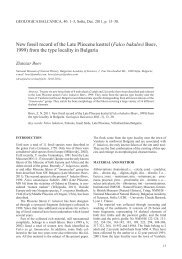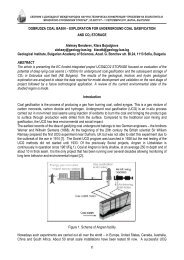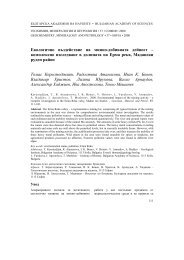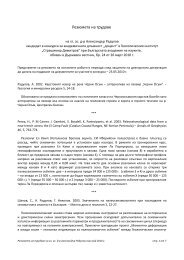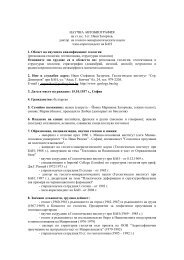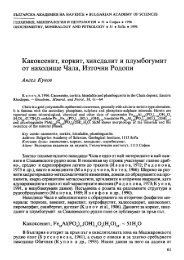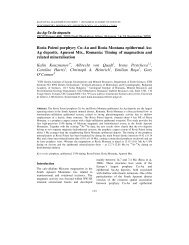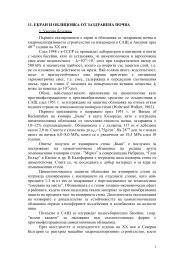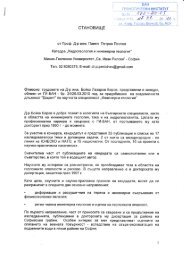2: Hydrothermal ore deposits related to post-orogenic extensional ...
2: Hydrothermal ore deposits related to post-orogenic extensional ...
2: Hydrothermal ore deposits related to post-orogenic extensional ...
Create successful ePaper yourself
Turn your PDF publications into a flip-book with our unique Google optimized e-Paper software.
70<br />
dominated by quartz–adularia and carbonate, which is<br />
consistent with the slightly lower temperature of<br />
homogenization for fluid inclusions of the quartz–<br />
sulphide assemblage (Petrov, in Breskovska and Gergelchev,<br />
1988a). There are no direct age determinations,<br />
but crosscutting relationships with precisely<br />
dated fresh equivalents of high-silica rhyolite suggest<br />
that mineralization is younger than 32.8 Ma (Marchev<br />
et al., 2003).<br />
4.2. Epithermal <strong>ore</strong> <strong>deposits</strong> in calc-alkaline <strong>to</strong><br />
shoshonitic complexes<br />
In the Eastern Rhodopes, epithermal <strong>deposits</strong> are<br />
mainly hosted by differentiated calc-alkaline, high-K<br />
calc-alkaline and shoshonitic volcanoes, sometimes<br />
associated with low-grade porphyry Cu–Mo occurrences<br />
in monzonitic <strong>to</strong> granitic s<strong>to</strong>cks intruded in the<br />
volcanic rocks. They variably exhibit characteristics of<br />
low-, intermediate-, and high-sulphidation <strong>deposits</strong><br />
P. Marchev et al. / Ore Geology Reviews 27 (2005) 53–89<br />
(Hedenquist, 1987; Hedenquist et al., 2000; Silli<strong>to</strong>e<br />
and Hedenquist, 2003), previously known as adularia–sericite<br />
and acid sulphate <strong>deposits</strong> (Heald et al.,<br />
1987).<br />
Intermediate-sulphidation epithermal Pb–Zn–<br />
Cu FAg–Au <strong>deposits</strong> are located within major Palaeogene<br />
shoshonitic <strong>to</strong> high-K calc-alkaline volcanointrusive<br />
centres of the Bulgarian Eastern Rhodopes<br />
(e.g., Spahievo in the Borovitsa complex; Zvezdel;<br />
Madjarovo), or m<strong>ore</strong> rarely within acid volcanoes<br />
(e.g., Losen; Fig. 3). Based on their well-expressed<br />
vertical zonation and their sulphide mineralogy,<br />
including Fe-poor sphalerite, high barite content and<br />
elevated fluid salinity, they are clearly of intermediatesulphidation<br />
character (Hedenquist et al., 2000; Silli<strong>to</strong>e<br />
and Hedenquist, 2003). Most of them are basemetal<br />
rich, and for about 40 years until 1995 m<strong>ore</strong> than<br />
16.5 Mt of Pb–Zn <strong>ore</strong> (Table 5) was extracted from<br />
Spahievo, Zvezdel and Madjarovo (Milev et al., 1996).<br />
At present, only the Pcheloyad mine from the Zvezdel<br />
Fig. 6. Simplified geological map of the Madjarovo volcano, showing the distribution of intermediate-sulphidation veins and 40 Ar/ 39 Ar ages of<br />
the host rocks and alteration; after Marchev and Singer (2002).



